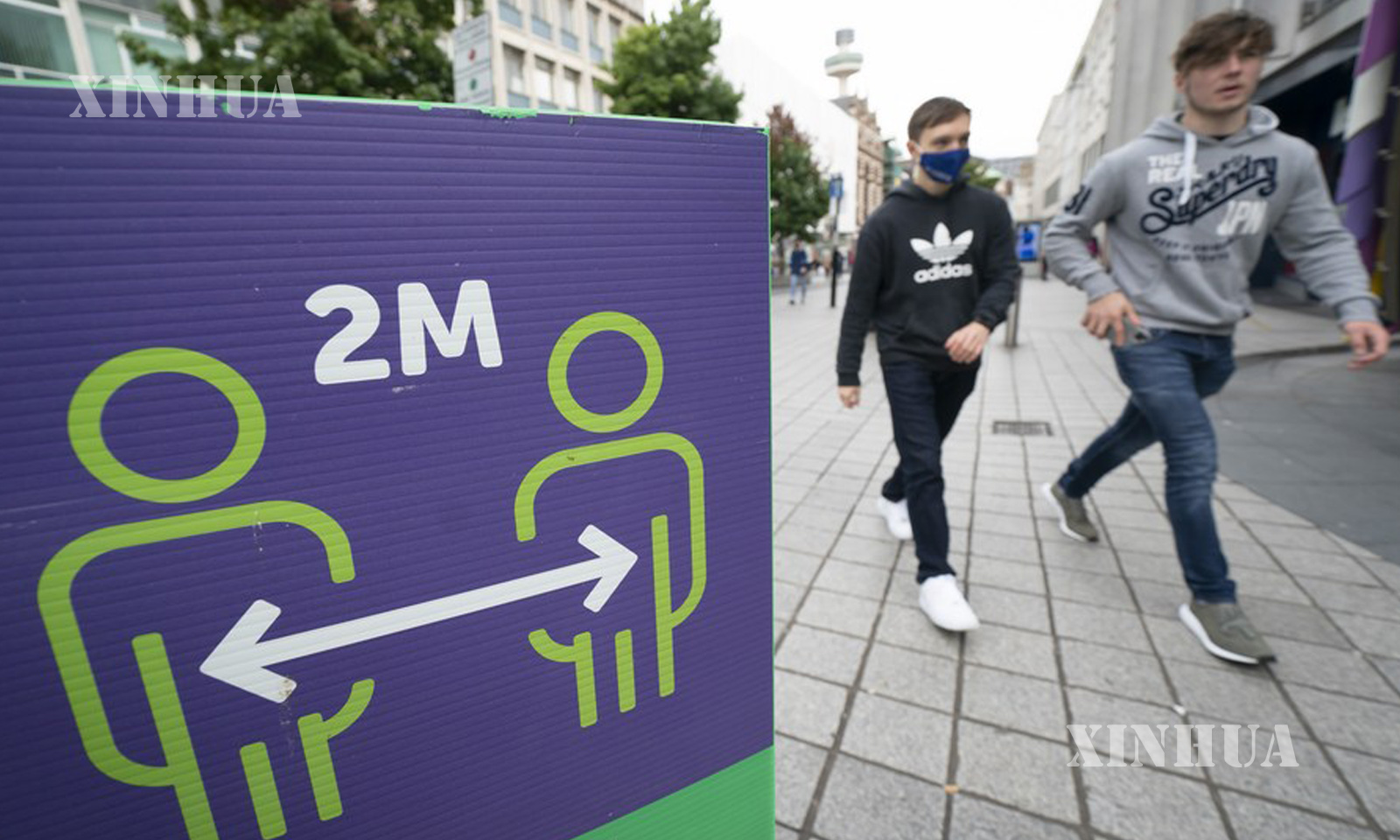COVID-19 UPDATES
ဥရောပတွင် COVID-19 ရောဂါအဆင့်က ကမောက်ကမဖြစ်နေ၊ မျှော်လင့်ချက်နှင့် စိန်ခေါ်မှုများ ဆက်လက်ဖြစ်ပွားလျက်ရှိ

စတော့ဟုမ်း၊ ဒီဇင်ဘာ ၂၉ ရက် (ဆင်ဟွာ)
ဥရောပတွင် ၂၀၂၁ ခုနှစ်အတွင်း COVID-19 ရောဂါ ဆက်လက်ဖိစီးနေပြီး ကမ္ဘာတစ်ဝန်း ကြောက်ရွံ့မှု၊ စိတ်ဖိစီးမှုများ ဖြစ်ပေါ်ကာ မျှော်လင့်ချက်များပင် ဆိပ်သုဉ်းသွားခဲ့ရသည်။

စပိန်နိုင်ငံ ဘာစီလိုနာမြို့ရှိ ဆေးရုံတစ်ရုံတွင် ရောဂါကာကွယ်ရေးဝတ်စုံများဝတ်ဆင်နေသော ကျန်းမာရေးဝန်ထမ်းများအား ၂၀၂၀ ပြည့်နှစ် မတ် ၂၀ ရက်က တွေ့ရစဉ် (ဆင်ဟွာ)

ဗြိတိန်နိုင်ငံ လီဗာပူးမြို့တွင် လူချင်းခပ်ခွာခွာနေရမည့် အကွာအဝေး သတိပေးဆိုင်းဘုတ်အတွင်း လမ်းလျှောက်နေသူများအား ၂၀၂၀ ပြည့်နှစ် အောက်တိုဘာ၂ ရက်က တွေ့ရစဉ် (ဆင်ဟွာ)
နွေရာသီတွင် အနည်းငယ်နာလန်ထူလာခဲ့သော်လည်း ပိုမိုကူးစက်လွယ်သော အိုမီခရွန် (Omicron) ဗီဇပြောင်းဗိုင်းရပ်စ် ပေါ်ထွက်လာခြင်းက ကပ်ရောဂါအခြေအနေမှာ ပြီးဆုံးရန်အလှမ်းကွာဝေးသေးကြောင်း ပြည်သူများ နားလည်သဘောပေါက်စေခဲ့သည်။
ရောဂါကူးစက်မှုများနှင့် ကာကွယ်ဆေးရရှိမှု မညီမျှခြင်းများ မြင့်တက်နေသော်ငြားလည်း ဥရောပတိုက်တစ်ခွင်ရှိ ပြည်သူများသည် တင်းကြပ်သောအစီအမံများ၊ ဆေးဝါးသစ်နှင့် ကာကွယ်ဆေးအသစ်များက နောက်ဆုံးတွင် ဆိုးဝါးလှသော ကပ်ရောဂါကို ထိန်းချုပ်နိုင်မည်ဟူသော မျှော်လင့်ချက်ရှိခဲ့သည်။
ကပ်ရောဂါ ရိုလာကိုစတာ
၂၀၂၁ ခုနှစ် နွေဦးရာသီတွင် ကိုရိုနာဗိုင်းရပ်စ်ရောဂါဖြစ်ပွားမှုနှင့် သေဆုံးမှုများ မြင့်တက်ပြီးနောက် ဥရောပသည် ဥမင်အဆုံးရှိ အလင်းရောင်ကို အမှန်တကယ် မြင်တွေ့ခဲ့မည်ဆိုပါက ပြည်သူများကို အံ့အားသင့်စေခဲ့သည်။
“ပုံမှန်အခြေအနေ ပြန်လည်ရောက်ရှိရန်” အတွက် ကာလရှည်ကြာခြင်းကြောင်း ပြည်သူများသည် လူချင်းခပ်ခွာခွာနေထိုင်ခြင်းနှင့် ခရီးသွားလာရေးတားမြစ်ချက်များ လျှော့ချခြင်းကို ကြိုဆိုခဲ့ကြသည်။
ထို့ပြင် ကပ်ရောဂါသည် လက်တုံ့ပြန်ခြင်းဖြင့် ပြန်လည်ရောက်ရှိလာခဲ့ပေသည်။
နိုဝင်ဘာလ တစ်လတည်းတွင်ပင် ဥရောပ၌ ရောဂါကူးစက်မှုအသစ် ၂ သန်းနီးပါးရှိခဲ့ပြီး ကပ်ရောဂါစတင် ဖြစ်ပွားချိန်မှစ၍ ဒေသတွင်း အပတ်စဉ် ရောဂါဖြစ်ပွားမှု အများဆုံးဖြစ်သည်။ ကမ္ဘာ့ကျန်းမာရေးအဖွဲ့ (WHO) ၏ အစီရင်ခံစာအရ COVID-19 နှင့်ဆက်စပ်သော လူသေဆုံးမှု ၂၇,၀၀၀ နီးပါးရှိခဲ့သဖြင့် ကမ္ဘာတစ်ဝန်း သေဆုံးမှုအားလုံး၏ ထက်ဝက်ကျော်ရှိကြောင်း သိရသည်။
“ဥရောပက ကျွန်တော်တို့ လွန်ခဲ့တဲ့တစ်နှစ်က ကြုံတွေ့ခဲ့သလို ကပ်ရောဂါဖြစ်ပွားမှု ဗဟိုချက်ပြန်ဖြစ်လာပါပြီ” ဟု WHO ၏ ဥရောပတိုက် ဒေသဆိုင်ရာ ညွှန်ကြားရေးမှူး Hans Kluge က ပြောခဲ့သည်။
နှစ်ကုန်အားလပ်ရက်များ လျင်မြန်စွာ ချဉ်းကပ်လာသည်ကို ပြင်ဆင်ခြင်းနှင့် ဗိုင်းရပ်စ်ကူးစက်မှု တားဆီးရန် ဆုံးဖြတ်ထားသည့်အနေဖြင့် ဥရောပတိုက်တစ်ခွင်ရှိ အာဏာပိုင်များသည် ကန့်သတ်ချက်များကို ပြန်လည်သတ်မှတ်ရန် အရေးပေါ်ဆောင်ရွက်လျက်ရှိသည်။ ယင်းအနက် နယ်သာလန်နိုင်ငံ အစိုးရသည် နိုဝင်ဘာ ၁၂ ရက်က တစ်စိတ်တစ်ပိုင်း လော့ခ်ဒေါင်း (lockdown) ပြန်လည်သတ်မှတ်ခဲ့သည့် ပထမဆုံး ဥရောပနိုင်ငံဖြစ်လာခဲ့ပြီး ၎င်းနောက်တွင် ဩစတြီးလျနိုင်ငံက နိုဝင်ဘာ ၂၂ ရက်၌ တစ်နိုင်ငံလုံး လော့ခ်ဒေါင်း ဆောင်ရွက်ခြင်းကို အကောင်အထည်ဖော်ခဲ့သည်။
အဆိုပါ အစီအစဉ်များနှင့် ဆောင်ရွက်ချက်များသည် တောင်အာဖရိကတွင် အိုမီခရွန် ဗီဇပြောင်းဗိုင်းရပ်စ် အမျိုးအစားခွဲခြားမှုထက်အလျင် ဆောင်ရွက်ခဲ့ခြင်းဖြစ်ပြီး ယင်းမျိုးဗီဇပြောင်းကိုရိုနာဗိုင်းရပ်စ်သည် ယခင်က တွေ့ရှိခဲ့သော ဒယ်လ်တာ (Delta) ဗိုင်းရပ်စ်ထက် ပိုမိုကူးစက်မြန်ကြောင်း၊ အိုမီခရွန်သည် ကာကွယ်ဆေး၏ ထိရောက်မှုကို လျော့ကျစေကြောင်း နားလည်ထားသော်လည်း ရောဂါလက္ခဏာဆိုးဝါးမှုကို လျှော့ချပေးကြောင်း အစောပိုင်းအချက်အလက်များအရ သိရသည်။
“သတိပေးချက်တွေကို ဆက်လက်လျစ်လျူရှုခြင်းနဲ့ ၎င်းတို့နိုင်ငံရဲ့ လူဦးရေကိုသာ အာရုံစိုက်နေခဲ့တဲ့ ကမ္ဘာ့ခေါင်းဆောင်တွေဟာ မီးနဲ့ကစားနေတာဖြစ်သလို အန္တရာယ်နဲ့ အကြိတ်အနယ် ယှဉ်ပြိုင်နေရတာဖြစ်ပါတယ်” ဟု Wellcome Trust ကုသိုလ်ဖြစ်ဖောင်ဒေးရှင်း၏ ဒါရိုက်တာ Jeremy Farrar က The Guardian သတင်းစာ၏ အမြင်ဆောင်းပါး၌ ရေးသားခဲ့သည်။
“ဒီကပ်ရောဂါကို ထိန်းချုပ်လို့မရနိုင်သေးပါဘူး။ အိုမီခရွန် သို့မဟုတ် ဆိုးဝါးတဲ့ဗီဇပြောင်းဗိုင်းရပ်စ်တစ်ခုဟာ ဘယ်အချိန်မှာမဆို ပေါ်ထွက်လာနိုင်ပါတယ်” ဟု ဗြိတိန်အစိုးရ၏ အရေးပေါ်အခြေအနေအတွက် သိပ္ပံပညာရပ်ဆိုင်ရာအကြံပေးအဖွဲ့၊ အဖွဲ့ဝင်ဟောင်းလည်းဖြစ်သူ Farrar က ဆိုသည်။
ခက်ခဲသော ဟန်ချက်ထိန်းညှိမှု
ကပ်ရောဂါကြောင့် တစ်ကမ္ဘာလုံးတွင် သေဆုံးသူ ၅.၃ သန်းကျော်ရှိပြီဖြစ်သည်။ ရောဂါဖြစ်ပွားမှုလှိုင်းများနှင့် ပေါ်ထွက်လာသော မျိုးဗီဇပြောင်းဗိုင်းရပ်စ်များသည် ကျန်းမာရေးစောင့်ရှောက်မှုစနစ်များအပေါ် ကြီးမားသော အခက်အခဲဖြစ်ပေါ်စေခဲ့ကြောင်းနှင့် ကန့်သတ်ချက်များကို အားကိုးအားထားပြုရန် အစိုးရများအား မကြုံစဖူးသော ဖိအားကို ဖြစ်ပေါ်စေခဲ့သည်။ သို့ရာတွင် ကပ်ရောဂါထိန်းချုပ်ရေး ဆောင်ရွက်ချက်များက စီးပွားရေးကို ထိန်းချုပ်ထားပြီး မြောက်များစွာသော စက်မှုလုပ်ငန်းများကို ပျက်စီးသေပြီး အလုပ်လက်မဲ့ဖြစ်ပွားမှုကို တိုးမြင့်စေကြောင်း သိရသည်။
ဥရောပ ခရီးသွားလာမှု၏ ကပ်ရောဂါအကြိုအဆင့်များမှာ ၂၀၂၄ ခုနှစ်အထိတိုင်အောင် ရရှိဦးမည်မဟုတ်ကြောင်း ဘရပ်ဆဲမြို့အခြေစိုက် ဥရောကခရီးသွားလာရေးကော်မရှင်က ခန့်မှန်းထားသည်။ အားကောင်းသောနွေရာသီ ပြန်လည်ရောက်ရှိလာသော်လည်းပဲ နိုင်ငံတကာခရီးသွားဧည့်သည်များသည် ဥရောပသို့ ရောက်ရှိလာခြင်းမှာ၂၀၂၁ ခုနှစ် နှစ်မကုန်မီအထိ ၂၀၁၉ ခုနှစ်အောက် ၆၀ ရာခိုင်နှုန်းသာရှိမည်ဟု ခန့်မှန်းထားကြောင်း ယင်းကော်မရှင်က ပြောကြားခဲ့သည်။
ဥရောပသမဂ္ဂ (EU) တစ်ခွင်တွင် အလုပ်လက်မဲ့နှုန်းသည် ၂၀၂၁ ခုနှစ် အောက်တိုဘာ၌ ၆.၇ ရာခိုင်နှုန်းရှိခဲ့ပြီး ၂၀၂၀ ပြည့်နှစ် အောက်တိုဘာလရှိ ၇.၅ ရာခိုင်နှုန်းမှ လျော့ကျလာခဲ့သည်။ စပိန်နိုင်ငံတွင် အလုပ်လက်မဲ့နှုန်းမှာ ၁၄.၅ ရာခိုင်နှုန်းတွင်ရှိနေခဲ့ပြီး ဂရိနိုင်ငံကမူ ၁၂.၉ ရာခိုင်နှုန်းရှိကြောင်း သိရသည်။
ဥရောပသမဂ္ဂ စီးပွားရေးသည် ကပ်ရောဂါ စီးပွားရေးကျဆင်းမှုမှာ မျှော်မှန်းထားသည်ထက် ပိုမိုမြန်ဆန်ခဲ့သည်။ ကာကွယ်ဆေးထိုးနှံခြင်းကမ်ပိန်းများမှာ တိုးတက်လာခြင်း၊ ကန့်သတ်ချက်များကို စတင်ဖြေလျှော့ခြင်း၊ နွေရာသီတွင် တိုးတက်မှုပြန်လည်စတင်ခြင်းနှင့် နွေရာသီတစ်လျှောက် မရပ်မနားဆက်လက်ဖြစ်ပွားမှုများက စီးပွားရေးပြန်လည်ဖွင့်လှစ်ခြင်းဖြင့် ကျောထောက်နောက်ခံပြုထားသည်။ သို့ရာတွင် အိုမီခရွန် ဗီဇပြောင်းဗိုင်းရပ်စ် ပေါ်ထွက်လာခြင်းနှင့် လျင်မြန်သောရောဂါကူးစက်မှုများက စီးပွားရေး အလျင်အမြန် ပြန်လည်နာလန်ထူရေးမျှော်လင့်ချက်ကို ရိုက်ခတ်နိုင်ဖွယ်ရှိသည်။
အနာဂတ်အတွက် မျှော်လင့်ချက်
လက်ရှိတွင် ကာကွယ်ဆေးရရှိမှုမှာ ရောဂါဖြစ်ပွားမှု ပိုမိုဆိုးဝါးခြင်းနှင့် သေဆုံးခြင်းကို ကာကွယ်ရန် အဓိကကျလျက်ရှိသည်။ သို့သော် ကာကွယ်ဆေးအား သိသိသာသာ ခွဲခြားမှုမှာ ဥရောပ အရှေ့ပိုင်းနှင့် အနောက်ပိုင်း ဒေသများအကြား စိုးရိမ်ဖွယ်ဖြစ်ကြောင်း၊ အထူးသဖြင့် ကိုယ်ခံအားလျော့နည်းမှုနှင့် ပိုမိုကူးစက်လွယ်သော ဗီဇပြောင်းဗိုင်းရပ်စ် တစ်ပြိုင်နက်တည်း ခြိမ်းခြောက်မှုများဖြစ်ကြောင်း သိရသည်။
သို့သော်ငြားလည်း ထိုအရာများသည် ထပ်ခါထပ်ခါဖြစ်နေသော လှိုင်းများနှင့် ဇဝေဇဝါဆုံးဖြတ်ချက်များအပေါ် တည်ထားသော အတွေ့အကြုံကြွယ်ဝမှုများဖြင့် မျှော်လင့်ချက်အတွက် အကြောင်းအရာများဖြစ်ကြောင်း၊ ဆေးဝါးအသစ်များနှင့် ပို၍ထိရောက်သော ကာကွယ်ဆေးအသစ်များက ထွက်ပေါ်လာမည်ဟု မျှော်မှန်းထားကြောင်း သိရသည်။
နောက်ဆုံး ရောဂါဖြစ်ပွားမှုအန္တရာယ် အကဲဖြတ်မှုတွင် ဥရောပ ရောဂါကာကွယ် ထိန်းချုပ်ရေးစင်တာ (ECDC) က ဥရောပတိုက်တွင် အိုမီခရွန်ပျံ့နှံ့မှုကို နှောင့်နှေးစေရန် “အလွှာပေါင်းစုံချဉ်းကပ်ခြင်း” အတွက် လိုအပ်ချက်ကို ထပ်လောင်းပြောကြားခဲ့သည်။
ယင်းအချက်တွင် ကာကွယ်ဆေးထိုးနှံမှုနှင့် အားဖြည့်ကာကွယ်ဆေးထိုးနှံမှု အရှိန်မြှင့်တင်ခြင်းအပြင် နှာခေါင်းစည်း တပ်ဆင်ရေး၊ လူချင်းခပ်ခွာခွာနေထိုင်ရေး၊ ထိတွေ့မှုခြေရာခံရေး၊ ထိရောက်သော လေဝင်လေထွက်ရရှိရေး၊ လက်ဆေးခြင်းအလေ့အကျင့် မြှင့်တင်ရေးနှင့် ဖြစ်နိုင်ပါက နေအိမ်မှအလုပ်လုပ်ကိုင်ရေး တွန်းအားပေးခြင်းတို့ ပါဝင်သည်။ ထို့ပြင် ထိရောက်သော ပူးပေါင်းဆောင်ရွက်မှုများ ပိုမိုလုပ်ဆောင်ခြင်းနှင့် ကောင်းမွန်သော အလေ့အကျင့်များနှင့် လက်တွေ့ကျသော အတွေ့အကြုံများလည်း လိုအပ်ကြောင်း သိရသည်။
“နိုင်ငံတွေအနေနဲ့ သူတို့နိုင်ငံ လူဦးရေတွေကိုပဲ ကာကွယ်ဆေးထိုးနှံထားတဲ့အတွက် ဘယ်နိုင်ငံကမှ စိတ်ချရတယ်လို့ ယုံကြည်ထားလို့မရဘူး။ ကမ္ဘာလုံးဆိုင်ရာ အတူတကွလုပ်ဆောင်ခြင်းကသာ ကပ်ရောဂါ အဆုံးသတ်ဖို့ ဆောင်ကြဉ်းပေးနိုင်မှာဖြစ်ပြီး အရေးပါတဲ့ ပြည်သူ့ကျန်းမာရေးအသုံးအဆောင်တွေအားလုံး မျှဝေခြင်းက နေရာတိုင်းမှာ ရောဂါကူးစက်မှု လျှော့ချဖို့နဲ့ လူ့အသက်တွေကယ်တင်ဖို့ လိုအပ်တယ်” ဟု Farrar က ပြောခဲ့သည်။ (Xinhua)
————————————
(English Version)
Yearender: COVID-19 upsets status quo in Europe, hope and challenges ahead
Source: Xinhua
Editor: huaxia
2021-12-29 02:05:30
by Fu Yiming
STOCKHOLM, Dec. 28 (Xinhua) — In 2021, COVID-19 has continued to ravage Europe, causing fear, stress and even despair across the board.
A brief recovery in the summer turned out to be more fragile than it looked, while the emergence of the more transmissible Omicron variant has made people realize that the pandemic may be far from over.
Despite rising infections and inequity in vaccine access, however, people across the continent hope that more stringent measures, new drugs and vaccines would eventually rein in the raging pandemic, which has threatened to stifle an early economic recovery.
PANDEMIC ROLLER COASTER
Following a surge in coronavirus cases and deaths in spring 2021, Europe enjoyed a summertime lull, which made people wonder if they were indeed seeing the light at the end of the tunnel. Longing for a “return to normalcy,” people welcomed the easing of social distancing and travel restrictions.
And then the pandemic was back with a vengeance.
In the first week of November alone, Europe reported almost 2 million new infections, the largest weekly case count in the region since the start of the pandemic. According to a World Health Organization (WHO) report, the week also saw nearly 27,000 COVID-19-related fatalities, more than half of all deaths reported globally.
“Europe is back at the epicenter of the pandemic, where we were one year ago,” said Hans Kluge, the WHO Regional Director for Europe.
In preparation for the fast-approaching year-end holidays and determined to curb virus cases, the authorities across the continent have been scrambling to re-impose restrictions. The government of the Netherlands, for instance, was the first in Europe to impose — or re-impose rather — a partial lockdown on Nov. 12, and Austria followed suit with a nationwide lockdown implemented on Nov. 22.
Most of these plans and measures predated the identification in southern Africa of Omicron, the coronavirus variant that is more transmissible than the previously dreaded Delta strain. Omicron is also understood to reduce vaccine efficacy but cause less severe symptoms, according to early data.
“World leaders, by continuing to ignore the warnings and focusing only on their national populations, are playing with fire and putting our hard-won progress at risk,” Jeremy Farrar, director of the charitable foundation Wellcome Trust, wrote in an opinion article in The Guardian.
“We are not yet in control of this pandemic — Omicron or an even worse variant could arise at any time,” said Farrar, also a former member of the British government’s Scientific Advisory Group for Emergencies.
HARD BALANCE
The pandemic has so far caused over 5.3 million deaths globally. Its recurring waves and the emerging virus variants have placed an enormous burden on healthcare systems and put unprecedented pressure on governments to resort to restrictions. However, these in turn stifled the economies, all but wiped out several industries and increased unemployment.
Pre-pandemic levels of European travel will not be achieved until 2024, the Brussels-based European Travel Commission has estimated. Despite a strong summer rebound, it said international tourist arrivals to Europe are forecast to be 60 percent below 2019 by the end of 2021.
Across the European Union (EU), the unemployment rate was 6.7 percent in October 2021, down from 7.5 percent in October 2020. The jobless rate was the highest in Spain at 14.5 percent, followed by Greece at 12.9 percent.
The EU economy had rebounded from the pandemic recession faster than expected. As vaccination campaigns progressed and restrictions started to be lifted, growth resumed in spring and continued unabated through summer, underpinned by the re-opening of the economy. But the emergence of the Omicron variant and rapid infections it has driven may have dashed hope of a quick economic recovery.
Paolo Gentiloni, European Commissioner for Economy, pointed out in November three key threats to the current expansion of the European economy: “a marked increase in COVID cases, most acute in areas where vaccinations are relatively low; rising inflation, driven largely by a spike in energy prices; and supply-chain disruptions that are weighing on numerous sectors.”
Meanwhile, adding insult to injury have been the mushrooming demonstrations in many European countries against COVID-19 rules and lockdowns, some of which even intensified into riots.
HOPE FOR FUTURE
The currently available vaccines have largely been able to protect against more severe cases or deaths. However, the stark vaccine divide between the eastern and western parts of Europe remains a serious concern, especially in light of the simultaneous threats of waning immunity and ever more transmissible virus variants.
Nevertheless, there are grounds for hope, with rich experiences built upon repeated waves and perplexing decisions. New drugs and more effective vaccines are also expected to come.
In its latest risk assessment, the European Center for Disease Prevention and Control (ECDC) reiterated the need for a “multi-layered approach” to delay the spread of Omicron in Europe.
This includes speeding up the vaccination and booster shot drives as well as encouraging or even enforcing mask wearing, social distancing, contact tracing, efficient ventilation, increased hand hygiene and working from home wherever possible. It also requires more efficient coordination of the national approaches and an exchange of good practices and practical experiences.
“No country should believe they are safe, purely because they’ve vaccinated their own populations,” Farrar said. “We will only bring this pandemic to an end by working together globally and sharing access to all the vital public health tools needed to reduce transmission everywhere and save lives.” Enditem
1- A mother and her children take a walk at the Trocadero Square near the Eiffel Tower, in Paris, France, Nov. 16, 2020. (Xinhua/Gao Jing)
2-Medical workers put on protective suits at a hospital in Barcelona, Spain, March 20, 2020. Spain has reported over 1,000 deaths of COVID-19, the disease caused by the novel coronavirus, the Spanish Ministry for Health, Consumer Affairs and Social Services confirmed on Friday. According to the ministry, 1,002 people have now lost their lives from COVID-19, in comparison with the 767 deaths a day ago. (Photo by Francisco Avia/Xinhua)
3-People walk past a sign reminding people to keep social distancing in the city center of Liverpool, Britain, on Oct. 2, 2020. (Photo by Jon Super/Xinhua)






